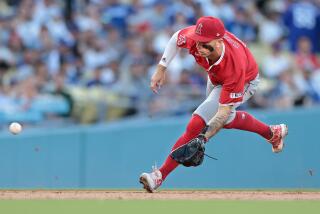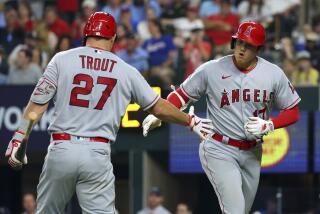Bright Sparks
- Share via
Most professional baseball careers are built on a foundation of fleet feet, bat speed or a fast pitch. But the Angels’ Steve Sparks got his start thanks to quick thinking.
After a couple of years as a shortstop-of-little-notice at Eastern Oklahoma Community College, he decided to try to walk on with the baseball team at Sam Houston State.
“There were a lot of infielders at the tryout camp and then I ran a really bad 60 [-yard dash],” Sparks said. “I overheard my time, so I turned to a coach and said, ‘Why are the pitchers running 60s?’ And he said, ‘Pitchers are supposed to be over there.’
“I was a long way from home, I’d pitched a couple of innings in junior college and I had a pretty strong arm, so I thought it might be a way to get my foot in the door.”
Sparks snagged a spot in the bullpen and pitched in relief his junior year. Then his sharp reasoning--he figured if he went to class, he’d stay eligible--paid off again.
“A couple of guys flunked out at Christmas break and they inserted me in the rotation,” he said. “I ended up having a good year.”
And by his senior year, Sparks had developed into a thinking-man’s pitcher. . . . If there’s a radar gun in sight, fling the thing as hard as you can.
“I’d seen guys who weren’t even the two or three best pitchers on the team get drafted because they had good arms and the scouts saw potential,” he said. “So I just went out there and aired it out whenever scouts were around because I knew that would impress them. It probably retarded my progress as a pitcher per se, but my main goal at that point was to try and get noticed.”
Mission accomplished. After going 11-0 as a senior, Sparks was selected by the Milwaukee Brewers in the fifth round of the 1987 draft. After five years in the minors, however, he was still shuffling between Class A and double A, his wits unable to overcome a not-so-fast fastball.
“I was pretty marginal,” Sparks says, smiling. “I had about a major league average fastball, an average curveball and everything else was below average. If I didn’t have really good control on any given day, it was a struggle to stay in the game. A guy who throws a little harder can get away with a lot more.”
Near the end of the 1991 season, the Brewers suggested Sparks try the knuckleball, figuring he had the necessary mechanics and demeanor, and really not much other chance of staying in baseball.
“When they first told me, I was mad, a little frustrated,” he said. “But after I had time to digest it a bit, I thought maybe they saw something in me that would warrant another chance. And I felt like it’s either this or get released.
“They gave me a three-year plan, which is a lot of leeway to develop a pitch, and I was 26 at the time. I figured there was no sense trying it at all if I wasn’t going to give it my best shot, so I went in with a good attitude.”
Another smart move.
WHERE ARE WE NOW, DADDY?
Ask a teammate about Sparks and he’ll usually end with the salutation, “I’m sure glad I don’t have to hit against him.”
Not catcher Charlie O’Brien. “I’d much rather hit against him than catch him,” said O’Brien, who spent much of spring training gyrating behind the plate chasing Sparks’ pitches. “There’s a whole lot less pressure.”
Sparks’ twist-in-the-wind deliveries lifted him to a 9-4 record last season and a one-year, $1.3-million contract for this year. But they’re arrow straight compared to the weaving course he took to the No. 4 spot in the Angels’ rotation.
“My wife [Michelle] and I just added it up the other day,” Sparks said. “We’ve moved 38 times in the 10 years we’ve been married.”
The tour included stops in Venezuela, the Dominican Republic and Mexico during winter campaigns as Sparks learned to coexist, and finally thrive, with the knuckleball. Michelle and daughter Alexa were constant companions.
Sparks made his belated major league debut with the Brewers in 1995, after eight seasons in the minors. He was 9-11 with a 4.63 earned-run average and led the team in innings (202) and strikeouts (96). In 1996, he bounced between the Brewers and triple-A New Orleans, but the knuckler was dancing to his tune in spring training of ‘97--he had just been tabbed for the starting rotation--when the music stopped.
“I was covering first base on a double play and the throw was wild,” he said. “I went back and got it and turned to throw as hard as I could to the plate. But the catcher was holding up his arms, so I just stopped. That’s when I felt the pop in my elbow.”
For 2 1/2 months, the injury was misdiagnosed, but Sparks was certain something was very wrong. He finally went to see Angel team physician Lewis Yocum, who told him the ligament was completely severed and later performed reconstructive “Tommy John” surgery.
Sparks was slowly working his way back to form last summer--with little statistical proof of recovery but a healthy arm nonetheless--when Angel Manager Terry Collins yelled for help. Sparks had been 0-4 at double-A Midland and was 0-4 at triple-A Vancouver but was still hoping to get the call because, “I was getting a better feel for the knuckleball with every outing.”
“I didn’t even know he was 0-8,” Collins said. “I called down and said, ‘We’re going to need a pitcher, who’s pitching best?’ They said, ‘Steve Sparks.’ I didn’t ask any more. And he came up and did so much more than we anticipated.”
Sparks performed his duties like a good knuckleballer should, chewing up the innings. He lasted seven or more innings in 14 of 20 starts.
But the Angels believe he did even more than win games and save the bullpen. They liked what they saw the day after he pitched. Opponents seemed to be suffering from a knuckleball hangover.
“There are what, four knuckleball pitchers in the big leagues?” General Manager Bill Bavasi said. “He provides a completely different look. If he pitches the first or second game of a series and goes nine, the other club’s done the next night too. It throws you completely off.”
DISLOCATION, DISLOCATION,
DISLOCATION
Sparks is dedicated, determined, driven and imaginative, but he won’t be reinventing himself as a left-hander. He has dislocated his left shoulder 15 times since 1989, has undergone three reconstructive surgeries and has nine hooks that hold it in socket . . . for the moment, anyway.
The original injury occurred in the minors when he hit a batter, who then charged the mound and Sparks tackled him. Dislocation No. 6 was during a rain delay in major league camp with the Brewers. Inspired by a motivational presentation, Sparks was attempting to rip a phone book in half. He ripped his shoulder out of joint instead.
The shoulder never bothers him now, unless he tries to extend his left arm beyond its limited range of motion, which means he doesn’t wave goodbye left-handed anymore.
It’s the right arm the Angels are counting on so heavily, however, and they’re buoyed by the fact Sparks brings a couple extra weapons to the mound along with his knuckleball.
“I’ve faced Sparky before when he was with the Brewers,” shortstop Gary DiSarcina said. “He throws [the knuckleball] a lot harder than most guys. And his other pitches are legitimate.”
Depending on the movement of his knuckleball--too much can be as problematic as too little--Sparks can also come after hitters with a decent sinking fastball or slider.
“I have a lot of my best games when the ball is moving just a little and I’m throwing a lot of strikes and the hitters are missing just enough,” he said. “But there are going to be times when you get behind in the count and being able to throw quality pitches that move in fastball counts, that’s a big plus.
“This is an explosive offensive team and my niche on this staff is to keep the team in the game. If I can go seven or eight innings every time, I’ll feel like I’ve done my job. But I’m not going to just show up. I want to put up as many zeros as possible.”
Like many knuckleballers, Sparks tends to string together zeros or give up runs in bunches. There’s often little middle ground.
“It’s a tough pitch to command and when things aren’t working, it can be ugly,” Collins said. “But sometimes you just have to leave him out there, because he might have one of those games when he gives up five runs in the first and then finds command and goes eight without allowing another run.”
And those are just the types of games the beefed-up Angels--with Mo power this season--hope to win, the games that might carry them over the hump and into the playoffs in 1999.
And then maybe Sparks, 33, will have to wander no more.
More to Read
Go beyond the scoreboard
Get the latest on L.A.'s teams in the daily Sports Report newsletter.
You may occasionally receive promotional content from the Los Angeles Times.






